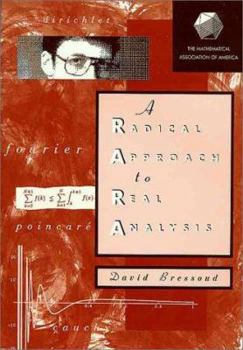A Radical Approach to Real Analysis
This book is an undergraduate introduction to real analysis. Teachers can use it as a textbook for an innovative course, or as a resource for a traditional course. Students who have been through a... This description may be from another edition of this product.
Format:Paperback
Language:English
ISBN:0883857014
ISBN13:9780883857014
Release Date:September 1996
Publisher:Mathematical Association of America (MAA)
Length:336 Pages
Weight:1.34 lbs.
Dimensions:0.8" x 7.1" x 10.0"
Customer Reviews
2 ratings
Excellent sequel
Published by Thriftbooks.com User , 14 years ago
If you had calculus in high school or college then you learned about Newton, Leibnitz, and Riemann but probably did not encounter Lebesgue (pronounced le-bek). At the University of Alabama Huntsville learning about Lebesgue integration is key to advancing into graduate studies in mathematics. The natural follow-on course after Calculus I and II, etc. is Real Analysis. This book, using Lebesgue integration methods, is a good sequel to Lebesgue calculus. I purchased this book, after reading about it in the Mathematical Association of America (MAA). For autodidacts like myself, it is a good first introduction to the topic.
Getting there naturally
Published by Thriftbooks.com User , 19 years ago
I am a topologist by training who was Shanghaied into being an analyst when I was hired as a teacher. As a consequence of this, the Advanced Calculus course I taught was rather heavy on topology. Over the course of time--having been transformed into more of an analyst that I would have ever dreamed--I've come to the conclusion that analysis is best learned before topology. This is a text that accomplishes that by using the historical approach. One learns how Newton approached problems, how Euler did, how Cauchy did. Not only is it interesting, it is enlightening. I've taught this course for 15 years now, and of all of the approaches I've taken, this has been the most fruitful. My students have come from calculational courses, and the historical approach of this book provides a bridge over which they may come into the land of proof. They also see the issues that caused the need for modern rigor face to face I do supplement the course with material that is more modern (Hardy's book A Course of Pure Mathematics) and material on the Riemann integral, but I've been spoiled for any other approach.






